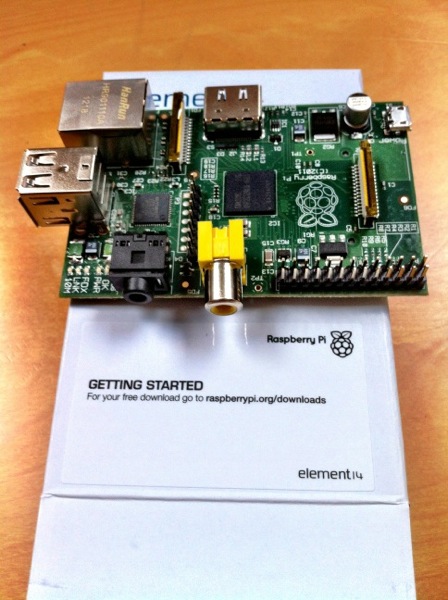
After months of waiting, after going through buyer’s remorse, then nonchalance, I received my Raspberry Pi today. My usual response to new hardware is one of automatic excitement. It’s excitement that comes from the amygdala, bypassing the neocortex altogether. So I was surprised to hear myself mumbling “meh”.
I am spoiled utterly by Apple, where you are sensuously connected to your purchase through sublime packaging that is an experience as seamless as it’s possible to have. I had to consider that I had spent 1/16th what I would on an Apple product, but in reality, product experience is seldom directly connected to wallet shock. Sure, if the experience is horrible, one is tempted to look at the price as further evidence of decision failure, but that tends to happen less and less nowadays. I’ll shut up about Apple in a minute, but it never happens with Apple product.
Raspberry Pi is a throwback to the Tandy era. It should strike me square in the amygdala, given how long I’ve been involved with computers, but it fails, because it isn’t the 1970s and this is pretending to be relevant now.
It’s not that it’s a bunch of chips and connectors on an open board that’s the problem. I’ve got a drawer full of old ISA cards, SCSI interfaces, Matrox graphics cards, PDS interfaces and the like, so I can live with that. It’s just so…unusable.
Here’s what I need before I can even use this device:
1. A USB power supply. (I don’t even know what one of those is actually)
2. An HDMI cable (All of mine are in use, but I could spare one I suppose)
3. A USB keyboard (my Apple ones probably won’t do the job, so I’ll have to order a cheap PC keyboard)
4. An SD card, not a generic one.
5. A USB mouse. (Not a problem, I have one or two lying around)
6. A monitor. (I have one, but it’s hooked up to a real computer)
7. An Ethernet cable to the router, which sits miles away from where I want to use the device
8. And of course, the piece de resistance – a real computer which is used to prepare the unprepared, uninitialised, unadorned Raspberry Pi board.
I will then have to prepare the SD card with one of several brands of Linux and I can then plug it in.
Given that I already have a computer, which can run Linux virtualised, and given that I’m probably going to have to spend well over a hundred quid to make this thing useful, what exactly is the point of this?





